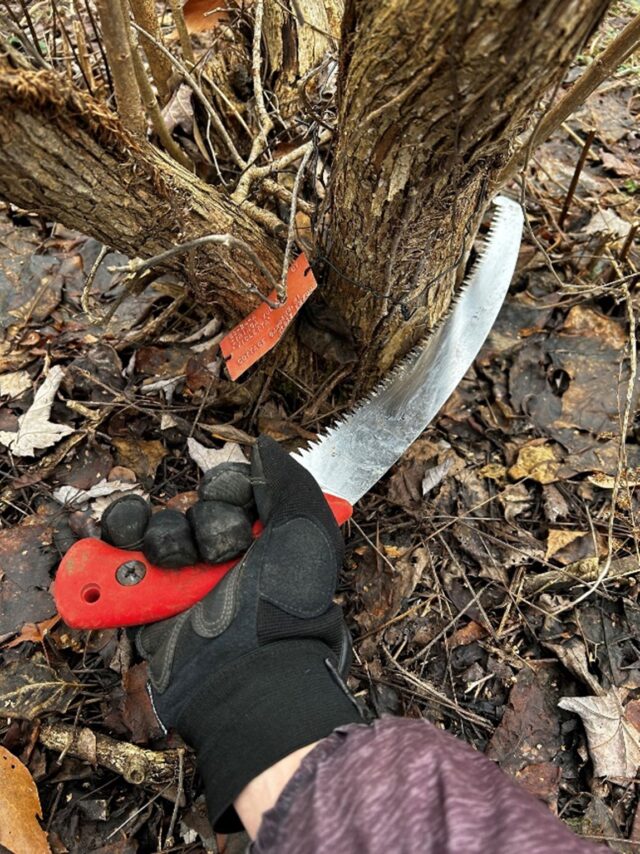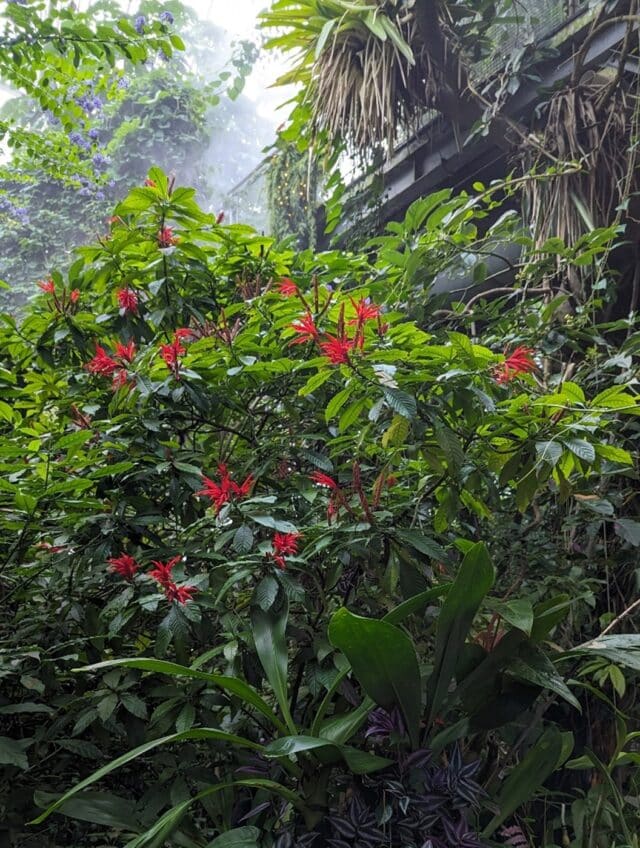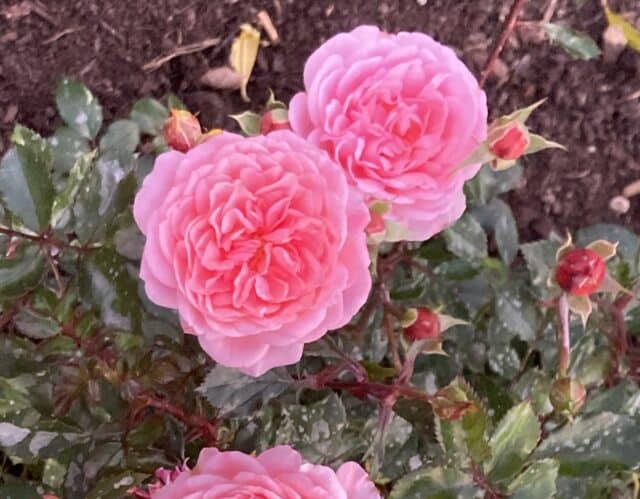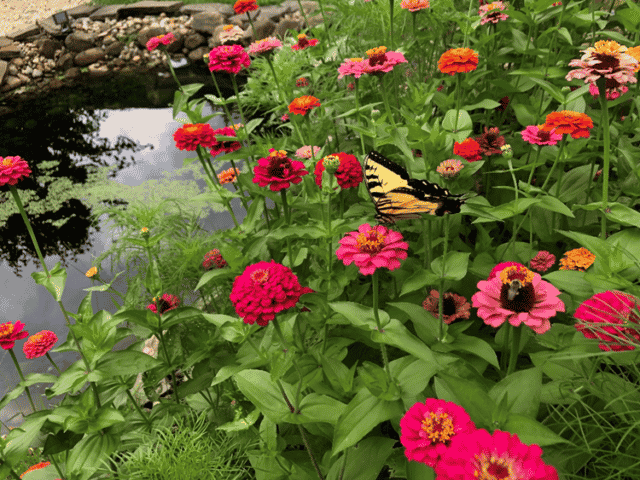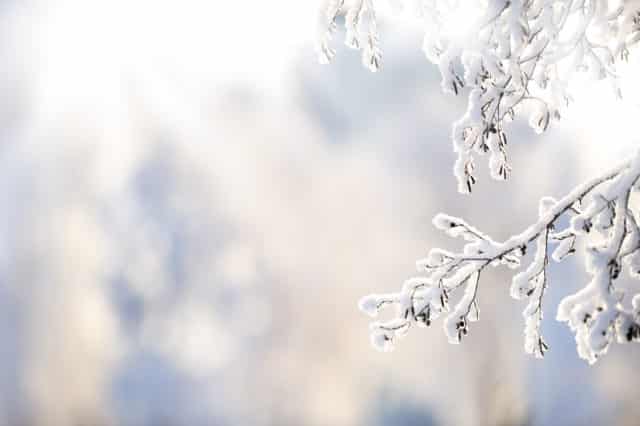Which Witch Hazel? – Sorting Through Hamamelidaceae Species During Winter Months
April 20, 2021

In Northeast Ohio, and other regions of the country with similar climate, winter holds trees and shrubs accountable for their actions. One family is resilient, or defiant, refusing to hold back when the temperature dips into the thermometer’s lower spectrum. Several members of the witch hazel family, Hamamelidaceae, prefer to flower during the shoulder-seasons, late winter-early spring and late fall-early winter. The boldest of them cracking bud in early to mid-January, the native species H. virginiana, flowers in October-November. The season extends further into December and even crossing into the New Year, with blooms held on zig-zag stems in the early weeks of January. Among the vast leafless tree and shrub forms growing within garden beds and native woodland, witch hazel family members dare to stand out and be noticed.
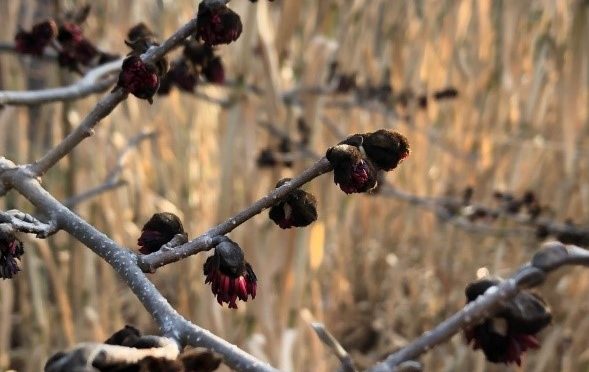
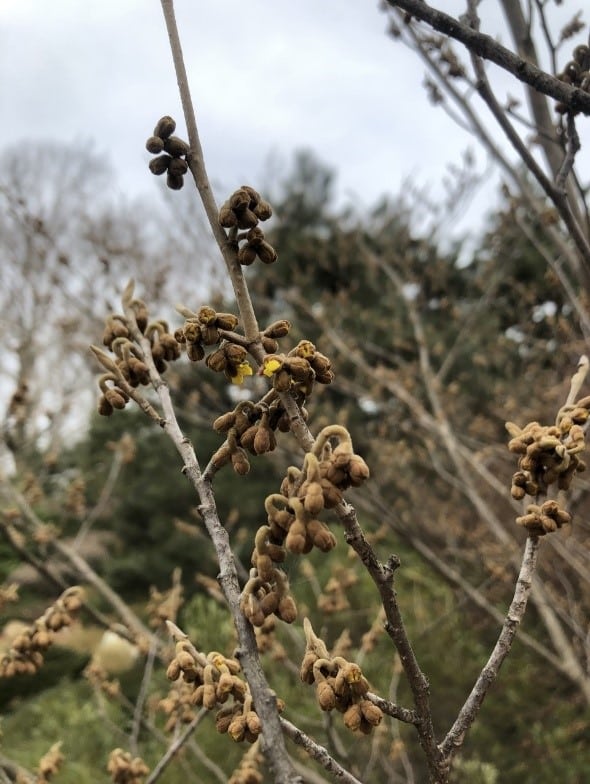
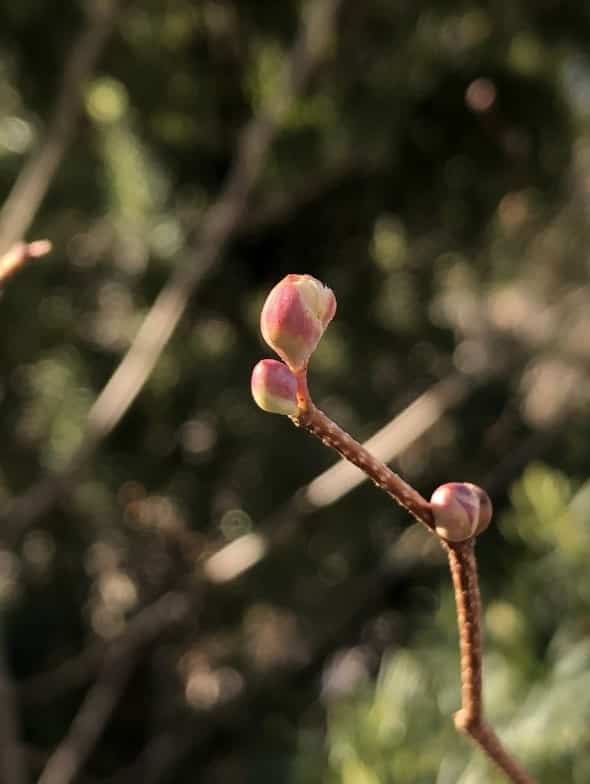
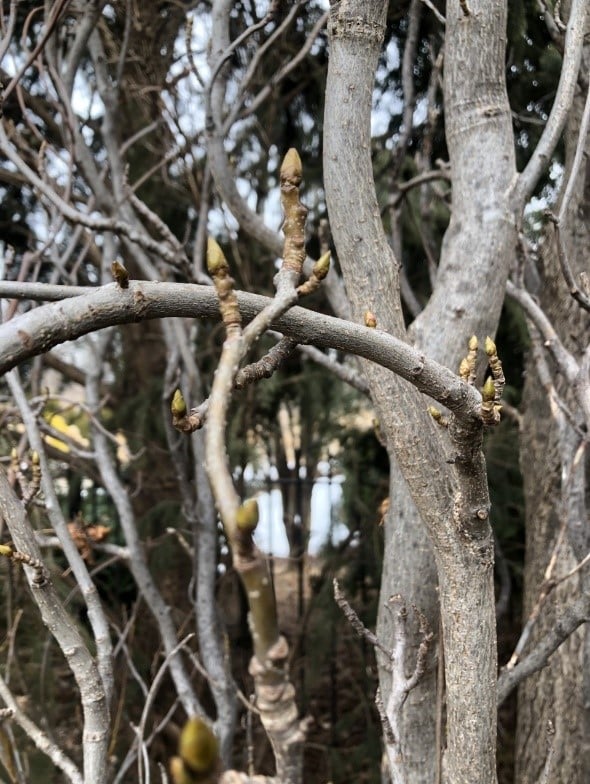
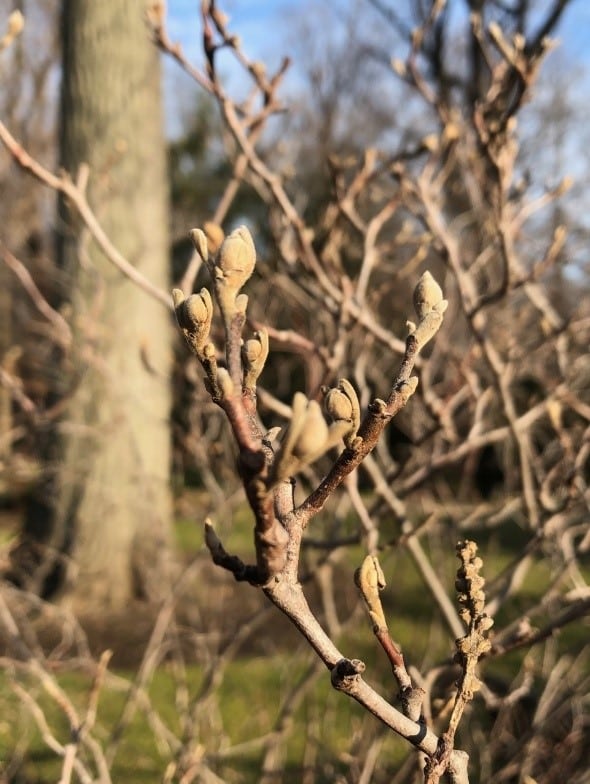
The winter months are a perfect time to become intimate with plants. Witch hazels and their cousins beckon us across the tan and gray landscape November through March. Gardens, woodlands, and open fields may be dotted with green shades of needled conifers and broad-leaf evergreens, but a dedicated plant enthusiast will seek out those plants of the witch hazel family. These plants are identifiable by their winter outline, their flower color, sometimes a striking bright, yellow glow from curly-pasta noodle-like petals that pepper their typical vase-like or upright rounded habit; and, if you are fortunate, remarkable scents ranging from but not limited to lemony-citrus and clove-like.
The Hamamelidaceae family is represented by several plant species that are native to Northeast Ohio and suitable for growing here. They include Corylopsis, Fothergilla, Hamamelis, Liquidambar and Parrotia. Of these, the species that can be found blooming when little else dares to flower includes Hamamelis commonly known as witch hazels, the winter hazels or Corylopsis, and Parrotia called Persian ironwood here in the United States. Fothergilla and Liquidambar begin to flower with the onset of slightly warmer temperature we typically see in April and May here in Ohio. You can key out these various species if you know what to look for and become familiar their interesting characteristics.
Meet one of the first to shyly put forth an array of inconspicuous flowers just into the New Year, Parrotia persica. This courageous species was opening in the Hershey Children’s Garden at the Cleveland Botanical Garden in mid-January this year. The blackish-brown buds have a soft pubescence, look like little winter hats – which somehow seem appropriate. Their buds crack open and apetalous (without petals) flowers emerge, allowing red-crimson stamens to poke out from a short winter slumber. These mature from pinkish maroon to yellow as the anthers shed pollen. You need to be quick to catch this because it happens in couple days’ time, but it is observable at varying stages throughout the plant and probably based on orientation of the sun and the warmth that is provided. This plant grows as a multi-stem tree-like shrub or as a single trunk. Either form usually forms a V-shaped head, growing 18-20’ wide and 25-40’ tall. The fall color when at its best is purple-crimson-red, but some specimens defer to a light or golden yellow. The puzzle-like, flaking bark includes pieces of brown, tan, gray, and green. It provides outstanding winter interest.
Next Hamamelidaceous family members to be observed flowering is the namesake witch hazels: vernal or spring types made of species from Japan or H. japonica, and China or H. mollis, and crosses or hybrids between these two species; known as H. x intermedia. There are more than 200 cultivars of these plants, but some have gone by the wayside because others with more redeemable characteristics have come forth. Some introductions have issues with powdery mildew and Anthracnose. Both foliage diseases detract from the summer appearance and reduce opportunity for a desirable display of fall color. The flower buds of all the witch hazels that bloom in winter and spring gather in clusters, hanging to the lower side of the branch like tiny, tannish brown sack lunches that split and unfurrow their strap-like petals. Flowering can start as early as January and run into late March. The floral parades of these species march along the plant’s stems in brigades of sulphury yellow to gold, orange, and shades of red. A well-positioned plant in the landscape will lead those attracted by the sweet fragrance to search around corners or cross over frozen lawns, just to find the source. These plants will typically range in growth from 8-12’ wide and 15-20’ tall. Weeping and dwarf forms do exist as well. Witch hazels are distinctly vase-shaped, rounded or a combination thereof. Fall foliage effect is variable, the best with reds that could rival any shows from a red maple or the orange-yellow of a sugar maple. The solid buttery yellow is not uncommon or undesirable either.
On the other side of the shoulder-season we can look forward to H. virginiana, the native witch hazel. It dots the landscape, typically growing with American beech and sugar maples in my hometown area of the Berkshires of western Massachusetts. The flower buds differ from the previously mentioned species in that they are concentrated at the tips of the branches and have a brown tone color. This species flowers in the fall, sometime in October through November, and sometimes into early December. The most common flower color is yellow to yellowish gold, but some red introductions are available from the trade. The native witch hazel exhibits a similar habit to its winter and spring blooming relatives, with a wide opened arm appearance – think of the Y-shape you make when singing “Y-M-C-A” by the Village People. It can grow as a large shrub or tree, commonly between 12-15’ x 15-20’, but 20-30’ is not unheard of for this understory plant. Fall color can range from shades of soft yellow and golden-yellow.
The winterhazels grouped under the species Corylopsis follow in bloom sequence after the winter and spring flowering witch hazels. There are about half-dozen or so species of the winterhazels and they all flower in March and April depending on the temperatures and location. Corylopsis bridges the gap flowering gap between the winter and spring flowering witch hazels and the next member of Hamamelidaceae, Fothergilla – more on this species a little bit later. These species flower in lighter shades of yellow to primrose. Before the flower opens, you can observe round-pointed buds on the noticeably zig-zag stems. The C. pauciflora or buttercup winterhazel at the Garden has buds that remind me of ripening McIntosh apples, pinkish red with undertones of green where the sun has yet to give the skin it’s ready-to-pick color. The fragrant inflorescence hangs when fully open, welcoming early pollinators to indulge in some much-needed nourishment. These are medium-to-large shrubs, and the horizontal branch structure is a good clue to use for identification.
Another member of this family is the Fothergilla, just as fun to say as it is to grow. Two species are most often found in the trade, however as recently as 2020 new species have been documented. For all intents and purposes, we will concern ourselves with two types of witch-alders, F. gardenii and F. major, or dwarf and large respectively. The dwarf species has smaller leaves and shorter stature, 4-5’ x 4-5’ and the large form grows closer to 6-8’ x 6-8’, up to 10’. They both have similar buds with a “king bud” at each branch tip, brown-tan in color and rounded ovoid in shape; the buds release apetalous flowers in April and May on leafless upright-rounded shrubs. Their fragrance is best described and honey-like, but this may be dependent on the temperature and person choosing to whiff the blooms. Summer foliage is variable and some with glaucous or silvery appearance can be found at local garden centers and nurseries. A selection named ‘Blue Shadow’ is a wonderful garden choice and there is an excellent massing on the back side of the visitor center at The Holden Arboretum on the inside of the steps that lead to the Butterfly Garden. In the autumn, not many shrubs are as reliable as the Fothergilla for a fiery yellow-orange to reddish purple show. You and the pollinators will appreciate this long-lived shrub, suitable for smaller and larger properties, just select the one that will grow to the appropriate size for the location.
Lastly, we look at the sweetgum or Liquidambar, the only true tree of the group mentioned here today. The species hardy for this area and similar areas of the country is L. styraciflua, or American sweetgum. The typical shape is pyramidal at a young age and rounds out with age. Mature sweetgum are capable of growing 25-30’ wide and 60-75’ tall. The winter form can cause some confusion as some selections have been introduced that are spire-like and as narrow as a rocket. The early, dormant stems have a spur-like appearance with buds atop which are fragrant when bruised. Flowers, both male and female found on the tree, appear in April-May as the leaves begin to emerge and expand. To tell these trees apart from maples, a commonly mistaken tree, use the bud arrangement – Liquidambar are alternately arranged, maples or Acer are opposite. A solid winter identification trait is the rounded, multi-pronged dried fruit that can be found scattered at the base or further spread out from passersby kicking them, from whirling lawn mower blades, or by being backpack blown into unsuspecting neighbor’s yard during the previous fall leave clean-up. Sweetgum’s fall foliage appeal overshadows the problematic fruit in my opinion. The leaves change from green to purple-red on the extremities and yellow to the interior; variegated or mottled varieties have a unique blush pink appearance that is an endearing sight in September and October. Enjoy life and all the plants you encounter.

